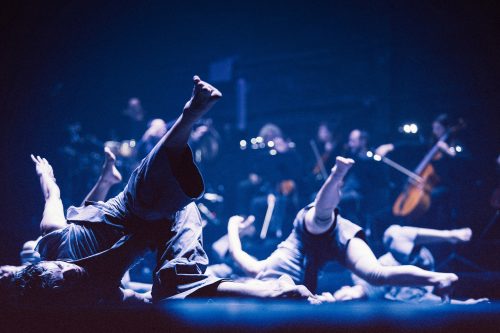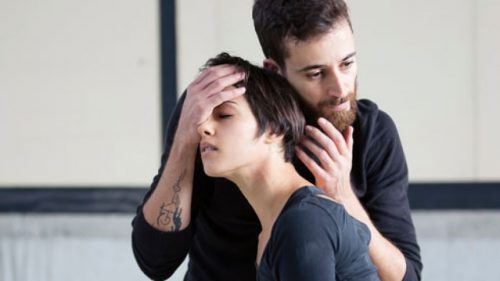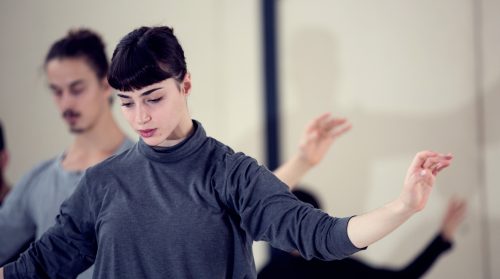Author Archives: GBvertigo
International Summer Master Class
A unique opportunity for a hands on experience of the Vertigo distinct movement language. Dancers from around the world are invited to participate in this challenging and inspiring 5-day workshop introducing the building blocks of the Vertigo dance language and Vertigo Dance repertoire. A rare opportunity to learn from dance masters and co-creators, choreographer and artistic director Noa Wertheim and her sister, assistant choreographer Rina Wertheim-Koren.
press here for more information and registration
Vertigo at the BAC


One. One & One – Inevitably Political Art. Tal Levin
Tal Levin, Achbar HaIr, February 17, 2017
Aiming for a peaceful creative process devoid of social context has ironically led choreographer Noa Wertheim to the creation of a forceful artwork itching to express the pains of life in Israel
A few years ago, I interviewed the founders of Vertigo Dance Company, Noa Wertheim and Adi Sha’al, asking them about the cultural differences between Jerusalem and Tel Aviv. Both, who over a long period opted for the Holy City, expressed their need for a peaceful façade-free space to enable the creative process. This prerequisite was apparently attained when the company (and family) moved to Kibbutz Netiv HaLamed-Heh, where they established the Eco-Art village, incorporating artistic creation and the promotion of community relations and activities. This geographic location to a certain extent hints to the status assigned to the creative path of Vertigo in the Israeli dance scene over the years, for better or worse dismissing popular trends. While upcoming local creation leans more and more towards the performing arts, further accentuating the political thematic approach, Noa Wertheim draws inspiration from spirituality, poetics and pure aesthetics.
One. One & One, a new dance piece by the Vertigo Dance Company, revolves around the spiritual aspect. The program includes a quote from the fifth tractate of Seder Moed (Order of Festivals) of the Mishnah: “And thus would he count: one, one and one, one and two, one and three, one and four, one and five, one and six, one and seven” (Yoma, Chapter 5, Mishna 4). Wertheim suggests an initial interpretation referring to the wish to be united versus separateness, the struggle between inside and outside, and so on. The opening movement accompanied by the chanting of words (“void”, “nature”, “space”, “discourse”, etc.) also resembles semi-abstract mantras. However focusing solely on this annoyingly vague interpretation may distract our attention from the actual political statement conveyed more forcefully than ever before by Wertheim who perhaps despite her intentions (whether expressing freedom of the creator or the creation) cries out the insoluble pain of the reality of our lives.
This piece begins with a dancer moving across a straight line pouring soil on the floor. Soon the soil covers the entire surface as dancers move, roll about, scattering grains in the air that become an integral part of their bodies. This choreography includes sections of restrained movement, confining the exploding energy of the dancers, as well as entire segments of raging ferocity. More than ever before One. One & One manifests Wertheim’s ability to move between these modes in a timely manner allowing the subtle moments to highlight the tempestuous and vice versa. With a precise amount of liberated motion, there is no exaggeration whatsoever, resembling a carefully choreographed no-rules wrestling with modest rhythmic and measured gestures. Likewise, the soil assumes various representations appearing as – a border, swarms of blood, a plowed field, a boxing ring and at the end – the sand from within a flapping winged bird emerges.
Even in its less powerful moments, Wertheim’s creation, inspired by the teaching of Mishna Yoma, focuses on earnest social contemplation. Not merely in the abstract sense of examining the ethical relationship between the individual and society, but reviewing the innards of “Israeliness” and the meaning of land as its source of strength as well as its Achilles heel. The fought for space as well as the substance, which is constantly ruined, wasted and mistreated.
The collaboration with musician Avi Balleli is one of the merits of this piece. In my opinion, the longstanding cooperation between Wertheim and musician Ran Bagno was beginning to show (and sound) played-out. Balleli complements this choreography with his own interpretation through music. Not merely accompanying the movement but creating a discourse, accentuating what the choreography attempts to conceal rather than the obvious. A subtle and peaceful segment transforms into an alarming battlefield simulation with the sound of firing cannons; and a reference to an Israeli pioneer dance from the early days of the establishment of the State gets an interesting twist with Arabic music. Another successful collaboration is with designer Sasson Kedem, who also designed the costumes for Wertheim’s previous work. Like Balleli, he accentuates elements, which perhaps she hesitates to express directly through her choreography. The result is a work of art that outlines a dense and gloomy climate. Nevertheless compelling us to follow the dancers to the finale, wave hands and hope for resurrection.

One. One & One – Contemplation Dance. Zvi Goren, HaBama
One. One & One – Contemplation Dance
Zvi Goren, HaBama, February 16, 2017
Noa Wertheim explores the individual’s ability to connect with the other in her new piece
The premiere of Noa Wertheim’s new piece joins at least another three milestones marking the 25th anniversary of the Vertigo Dance Company, founded by Noa with Adi Sha’al. They first met at the Jerusalem Tamar Dance Company, danced a duet titled Vertigo later to become the name of their new founded dance company.
Nature as a Medium
Together ever since, their adventurous journey incorporates dance and the unique lifestyle that have led them to build an ecological village where alongside family members, artists and dancers, they reaffirm the link between art, human and nature. Their elaborated story published now in a fascinating album book titled, Vertigo – A Choreography of People and Dreams, written by Uriah Kadari for HadKeren publishing, is yet another well-deserved cause for celebration.
Another milestone is the recent decision of the Israel Culture Administration to award Vertigo the status of a major dance company acknowledging the remarkable scope of their cultural contribution that includes dozens of international performance tours – from China to Morocco, Ethiopia to South America, the United States, the Balkans and all of Europe.
In this new piece created together with her sister, Rina Wertheim-Koren, Noa resort again to nature as a medium. A prism that allows for further observation of the human soul, the individual’s oneness or personal unity as well as the ability and desire to connect with the other. Set across the deserts of loneliness, detachment and separation and the immense longing to reunite, this is, in essence, a depiction of the course of a social life, from the smallest cell to the collective.
Anticipating a Great Drama
Indeed, this piece opens with two separate individuals: a male dancer pours soil along the front of the stage, while a female dancer concentrates on a magnificent solo interrupted only when three male dancers embrace and lead her into the expansive realm of human reflections. Moving along a seemingly fashion runway dressed in the beautiful costumes designed by Sasson Kedem, passerby pace back and forth on a map of intertwining streets featuring random contacts, selected connections, and the inevitable separation.
Gradually, dancers add strips of land, until the entire stage is covered. This scene serves to confirm the impression that this is Wertheim’s attempt to review her roots. It seems to refer to the move to the ecological village that resembles a separation from urban living and connecting to the organic way of life, as well as to the building blocks of her distinct dance language through quotes from her early creation of Birth of the Phoenix.
Wertheim picked a thought provoking theme: “And thus would he count: one, one and one, one and two, one and three, one and four, one and five, one and six, one and seven” (Yoma, Chapter 5, Mishna 4). There is a nice sound to it however, the message it conveys is quite startling taken from a text relating to the Yom Kippur sacrifices. There is also a military adaptation of this particular motto used in handling a grenade – “And thus would he count: twenty-one, twenty-two, twenty-three – explode”.
Dancers Exploding with Talent
From beginning to end, we can experience a great drama, not necessarily linear although in some scenes there is an apparent narrative. Throughout this choreography, voicing the inner restraints while responding to new laws that defy the old order, the movement itself is dramatic. Each and every dancer is brilliant – four female dancers: Liel Fibak, Nitzan Moshe, Shani Licht and Tamar BarLev; and four male dancers: Etai Peri, Sándor Petrovics, Daniel Costa and Ron Cohen – exploding with talent and spectacular movement.
Indeed, an explosive effect is created on the set, accentuated by but not limited to the upbeat as well as the more soothing music of Avi Balleli. The sacrifice ritual is omnipresent. Forms of structure vary from duets to trios, a solo, an ensemble, and the grand dance company, which they are. Constantly observing each other, disappearing from the setting, designed by Roy Vatury and the lighting, designed by Dani Fishof-Magenta, only to return and revive the land that was not sown with their faith and their craft.
Hence, the time has come to a festive meeting with the Vertigo Dance Company celebrating their 25th anniversary.
